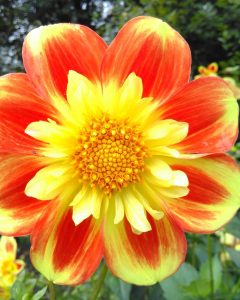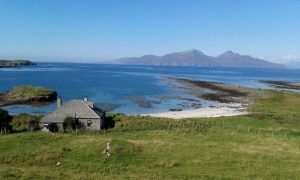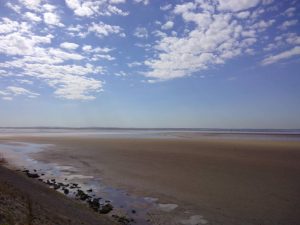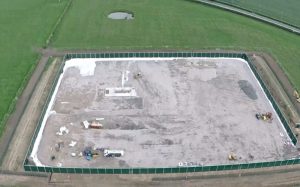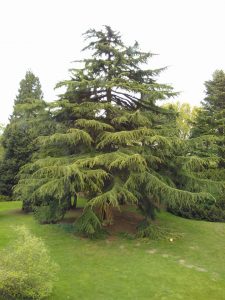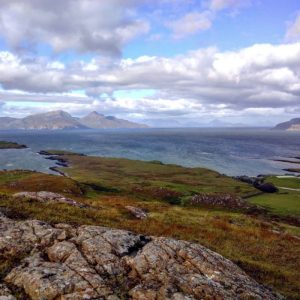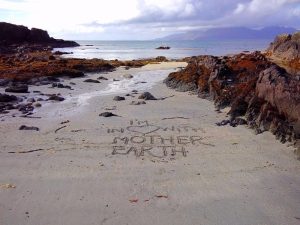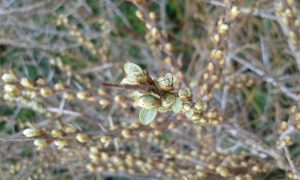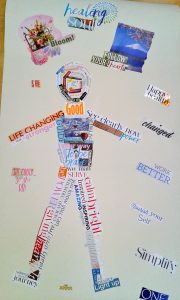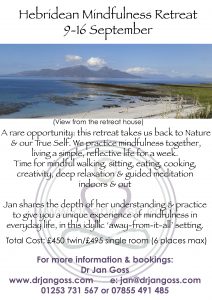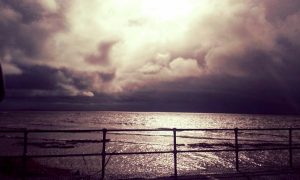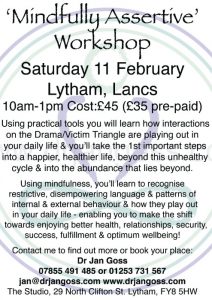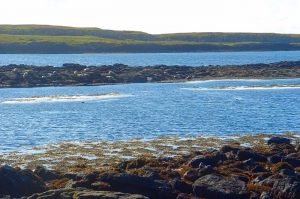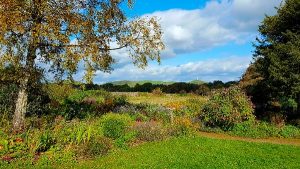Jan Goss
Dropping Into Body
Dropping into Body.
‘Breathing mindfully takes our mind back to our breath and, if we continue, to our whole body‘. This is the first line from a reading by Thich Nhat Hanh that I often use during the deep relaxation that I guide on retreats and retreat mornings. It goes on to say ‘We go back to our body and reconcile with it. We get to know what’s going on in our body, the wrongs we have done, the conflicts we’re having, and we’ll know what to do and what not to do in order to be on good terms with our body‘.
Our body is precious and central to our life, and yet we so easily become disconnected from it, overriding and ignoring it’s wisdom. If we have a headache, or something more serious, our body is communicating something to us. If we stop and pay attention (the essence of mindfulness) we can discover what it is telling us and we can choose how to respond. We need to be conscious of our body through the ‘good’ times, so that our body doesn’t need to shout its message in the form of more serious dis-ease.
I remember the tutor, when I undertook my art therapy training, saying if you have a headache you can take a tablet or you can find out why! Finding out why, takes time and patience – both of which seem to be increasingly rare commodities – and of course it involves some discomfort, the ‘being with’ as opposed to the ‘rushing to fix’ and annihilate pain and suffering. A headache can usually be easily remedied by drinking a pint of water, going for a walk, or meditating. A headache like everything else is impermanent, shifting from moment-to-moment, and yet the need to make it go away ‘immediately’ is common, and indicative of our quick-fix culture.Taking a tablet means we can ‘carry on as usual’, without adapting our behaviour, but it doesn’t get to the source of the problem and it simply masks the body’s message.
If we understand our whole body to be ‘mind’, that is, each cell in our body has intelligence and each cell has the capacity to heal itself, then we are more likely to support the healing of our body in whatever way necessary. The body is a miraculous ‘self-righting’ system, however the body-mind connection is not commonly or fully understood. What we see as ‘symptoms’ are part of a complex communication system that often baffles scientists who insist that cures are ‘out there’ waiting to be discovered, when to a large extent, the power to heal lies ‘in here’. Our minds are as powerful, as our bodies are miraculous, and consciously or not, we are creating our future in each moment, with each thought we think and with each choice we make.
Mindfulness brings us back into our body and helps us to be more ‘conscious’. In meditation we see the boundaries between phenomena disappear and at this deeper level of consciousness and understanding, everything becomes ‘one’, ‘whole’, irrevocably connected, without effort. As we become melded with the present moment, we connect deeply with all that we encounter and we realise that we are always experiencing life from the inside out. As we drop into our body and pay attention to it, we learn more about it and how best to support it, to keep it functioning efficiently and optimally. Mindfulness is a holistic practice, it takes care of the whole person, not just the brain and cognitive function.
At the Wednesday meditation group at my home last week, we got into discussion about ‘happiness’ and what exactly that is? Between us we came to an understanding that there is an ‘outer happiness’ that comes from the material world of ‘things’, that is fleeting and leaves us wanting to consume more; and there is a happiness that comes from within, that is generated by spiritual experience and has as it’s essence feelings of joy and peace, it is lasting and we can build on it from moment to moment – the source of this inner happiness is always available to us and it is free! However, it takes ‘practise, practise, practise’, as Muriel says in the article below.
When I work one-to-one with people we usually spend some time in mindful dialogue and then often, some time connecting deeply through meditation. Guidance is more than simply words, there is an exchange or transmission of energy that takes place, a feeling of complete peace, of wholeness, that is more easily generated with two or more body-minds. It is not possible for me to guide someone to a place that I have not been myself, this is why my own continuing personal development, in the form of attending retreats and associated trainings is pivotal to the experiences I can offer to you.
It has been a particularly full and rewarding twelve months for me, in terms of my personal development. I trained with the Psychosynthesis Institute in London, undertaking their Fundamentals course followed by a PG Cert. in Leadership Coaching and I have been deepening my connection to body through somatic work and this November embark on Hakomi body psychotherapy training. So, in some respects I feel I am only just beginning to ‘drop into body’ and understand myself in a way that only body can reveal – and in another way, I feel I know ‘body-mind’ very, very, well indeed, we have been through a lot of trauma and healing together.
So, this is an invitation to you, to drop into your own body and ‘get to know what’s going on in your body…to know what to do and what not do do, in order to be on good terms with your body. You may like to use the deep relaxation that I offer, to help you, or you may like to book onto a retreat or come and see me for a private appointment in Lytham or Lancaster.
Meeting Jan in the Lifehouse our local healthstore in Lytham, more than five years ago, became a landmark in the journey of my life. Jan invited me to her mid-day mindfulness meditation group meeting to which I went, and so began my exploration into mindfulness itself.
Those early group meditation meetings were so meaningful, for they brought the beauty and benefit of the quiet mind, the recognition of the body through focused breathing and awareness of the senses. They were also social occasions, for I met many lovely and interesting people.
The aspects of mindfulness for which I am most grateful are:
From these early beginnings, I read extensively the works of Thich Nhat Hanh, attended Jan’s workshops and retreats, all helping to mould and deepen my appreciation of mindfulness and the effects it has had in my life and wellbeing.
- Awareness of the present moment – being conscious of thought, experience and events as they happen
- Acknowledgement of them
- Acceptance that it is in the present moment I accept what occurs
- Non-judgmental – looking at things and events in an objective and not subjective way
- Letting go – not hanging on to my thoughts, feelings etc
– With many thanks to the legend that is Muriel Ingham, aged 96 years young!
I wrote to myself after the first formal introduction I had to mindfulness 18 months ago. Through work a group of us completed a ‘mindfulness for stress’ course. My letter to myself was to remind me of what I learned on the course. My notes include:
1) Judge and react less, notice and respond more
2) Remember we’re biased towards negativity so allow more time to dwell on the positives.
3) Apply a just right effort with practice, not too hard nor insufficient.
4) Start with kindness to myself (that’s a biggy to me, harder said than done)
5) Notice when I’m making it harder by how I am thinking, let go of secondary suffering
6) Keep considering “Being, not only doing”
7) Send out smiles.
Once the group finished I continued to practice, but feeling like a lone wolf I needed to connect with others and joined Jan’s meditation group. All my notes in my letter have more meaning and richness through developing practice in a group. Moving through the ideas in the “book group” was an even better way of making the practises and meditations real. It was so beneficial to learn from the wisdom of the other participants’ experiences and of course Jan’s sensitive and person centred guidance.
It feels like I am coming home to ideas that I have long considered but didn’t know were in the world of mindfulness. After some deep thinking and individual consultation with Jan I have found the courage to pursue further training in mindfulness. Eventually I hope to help others experience the benefits for themselves in the areas of stress and pain.
Personally I feel calmer, more appreciative and much more centred in my life. In truth, mindfulness practice has helped me relate to job redeployment and making my way in a new post, a friend’s tragedy and the ups and downs of life, in a better way than before. There’s no going back now, continuing to balance and practice is for the rest of life, a moment at a time. (G)
On Beauty & Vulnerability
On Beauty & Vulnerability
I’m fortunate to be surrounded by beautiful people! Individually and in groups, I have the pleasure of working with such lovely people. I am so grateful to do the work I do and know the people I know, beauty is all around me.
I am acutely aware at the moment that there are so many people doing so much good in the world, groups of all sizes standing up for what they believe in and being the change they want to see in the world. Now more than ever, people seem to be uniting across the world. If we watch the news we may get caught in a different perception of the world, one of division, violence, hatred and fear, and of course this is far from the whole picture. For every ‘bad’ news story there are thousands of ‘good’ news stories, but of course they don’t very often make the headlines.
Last month I spent four days in Windermere with interns and their managers, from various charities throughout Britain. I led sessions on mindfulness and leadership, as part of the Rank Foundation’s Time To Shine project, which gives young people twelve months paid experience, to enable them to complete a project for the charity they are working with. I learned of so many charitable organisations that I didn’t know existed and I heard some incredible personal stories. It is so heartening to know that there are projects and people like this. Without exception the young interns were all such amazing people, a diverse group with one common aim of making a difference. In this environment is was so easy to see the beauty in the world.
Mindfulness encourages us to see what’s good in the world, to see the beauty that is within and around us, in every moment. We become more aware of the birds and their song, the trees and their leaves, other living beings and their beauty, in all of their guises. Even in the most difficult and ‘ugly’ of situations we can choose to look for beauty – a noble gesture, an act of kindness, or a smile. Locally, I see the beautiful local/national/global community that is building as a result of the fracking. Even the darkest cloud has a silver lining if we are open enough to see it.
Mindfulness enables us to open our heart as well as our mind, to be authentic, to speak our truth at the ‘risk’ of being vulnerable. And if we can stand fully in the vulnerability of our human being-ness, fear naturally falls away. Mindfulness enables us to access the clarity that makes it possible to see our own beauty as well as the beauty in the world around us, it enables us to see the silver lining more clearly.
The beauty of Nature is wonderful in itself, but it also reflects our beauty, we open up in Nature as we allow ourselves to be just as we are in each moment, knowing that we are accepted just as we are. Mother Nature doesn’t judge she just holds and supports us. The Isle of Muck in the Inner Hebrides is my favourite place to ‘be’. The picture above is of the house we use when on retreat there, the white sandy beach and the clear blue sea just a few steps from our door. This year’s retreat which takes place from 9-16th September will focus on our connection with self through Nature and through mindfulness practice, it’s easy when we’re here because we are held by the elements that constitute Nature and we can relax into her and our self, we can just ‘be’, as we have maybe never ‘been’ before. It is such a beautiful experience and great healing and transformation take place. If the the idea of ‘Being in Nature’ resonates with you, and you may like to join me for the week, then please let me know. There are just 2 places left – you can call me on 07855 491485.
Time Out and Sadness
Do You Need Time-Out?
We all need time-out from the challenges of everyday life and the busy-ness of our minds and yet, quite often it is the one thing that we forego in deference to more ‘doing’, more busy-ness. We are often addicted to being busy, in an attempt to distract our self, from our self and of course it works at times and for a while – so that motivates us to continue on that path, to keep filling the diary with this and that.
If you find it difficult to make time for regular meditation practice, or live quite a way from where I hold my weekly classes, you might like to consider coming along to a Retreat Morning, there is one on the first Saturday of each month – next one Sat. 1 July from 10am-1pm. These sessions are ideal if you are feeling a bit off-balance, stressed, or just want time to your self, to connect with your inner calm. It is like a mini retreat! So, the invitation is there, if you feel it might do you good, the deep relaxation alone, is very nourishing – it’s like that bit at the end of a yoga session, but for about 40 minutes!!
Feelings of sadness…
This is the nation’s first fracking site – there are just under 100 of these propsed for the area in which I live. Green-field sites are ear-marked for being concreted like this one and then drilled – there will be about 4000 wells within a 50 mile radius. I can’t help but contrast this with the picture above of the beautiful coastline, just a few minutes drive away.
The gateway to the site on Preston New Road is a place where concerned individuals gather to show their resistance. I go there to meditate. I do mindful walking up and down the road to help me come to terms with the deeply penetrating feelings of sadness that I have. I walk past the gate and less peaceful protestors, and the police, in a bid to bring some calm – it seems to have some positive effect and I feel better.
At the end of August some monastics from Plum Village in France (the community of Thich Nhat Hanh) are coming to the site also. And during the month of July Reclaim the Power, a national organisation who are concerned about environmental issues are also offering their support, planning events and actions in an attempt to slow the progress of the shale gas industry.
For me, living a mindful life means doing my best to protect the environment and of course I want to do that and show my support in as peaceful a way as possible. I am heartened that there are people from all over the world who care enough to come and ‘stand’ with us. On 8 June Friends of the Earth Europe gathered at the site offering support (click here to see the video) and the last Friday of each month is dedicated to ‘No Faith in Fracking’ for people of all and no faith to come together peacefully…of course this is not the image often portrayed by the media.
Walking meditation is a wonderful practice that helps us to work with our body and mind, especially at times when we have extreme emotions that we want to come to terms with – if you haven’t tried it, I recommend that you do:
-
Slow your walking down to a ‘snail’s pace’ and then slow it down some more. Feel each movement of each step, the heel making contact, the ball of the foot, the toes, and the feeling of the other foot leaving the ground and lifting and moving forward. Feel your connection to the Earth and be thankful for the life that it makes possible.
Of course it is a lovely practice on a white sandy beach too. We will be doing plenty of that on the Isle of Muck, Inner Hebrides, on the retreat in September – there are still a couple of spaces available for that if it is of interest to you – and you may be eligible for a discount too, please contact me to ask…that really is time-out!
Creating Space to Reflect
Creating Space to Reflect
I feel a slight change approaching, in the form of my work, this happens from time to time. For all of us, it is important to notice when it is time to change things and be flexible and courageous enough to let go and move forward.
I am currently undertaking training in Psychosynthesis Leadership Coaching and this will contribute to changes I wish to make in offering Mindful Leadership Coaching & Mindful LeadershipTraining. It is beginning to be acknowledged that mindfulness offers great scope for personal growth and human potential, in addition to it’s proven therapeutic benefits – indeed, that was the thrust of the empirical research I carried out at Lancaster University for my Ph.D. The words ‘Mindfulness’, ‘Leadership’ and ‘Coaching’ sit together very well and Mindful Leaders who are able to consider a broader and deeper view, are needed now, more than ever.
I am working increasingly with progressive organisations such as Carillion plc, the Rank Foundation, Lancaster University and the RNLI, who see the value in supporting people to take time out to reflect and identify personal strengths as well as areas for growth, simultaneoulsy restoring their wellbeing. Typically, and somewhat paradoxically, time given to personal and professional reflection is an invaluable resource that ensures greater ‘productivity’ and ‘success’, in any field, however measured. On a personal level too, my private clients really value and benefit from regular reflective space. We all need this to gain clarity and move forward effectively and happily.
The growth of mindfulness training is rapid in the UK as many of the people who have developed their own practice, want to undertake further training so that they can introduce others to the benefits that they have enjoyed. Five years ago, when I was at a gathering of any kind and people asked me what I ‘do’, they would often look at me quizzically when I mentioned mindfulness, now, almost everyone I talk to has some experience of it, personally or through the media. Mindfulness has gone mainstream and often features in programmes such as The Truth About…Stress (available here on BBC iplayer). The continued longevity of mindfulness seems certain. There have been one or two (and only one or two) skeptical swipes at it over the years, but they haven’t gained any momentum, because the results from research are all so encouraging and people are trusting their own experience of it. It simply ‘works’.
I have also worked with a great number of people who are in the therapeutic field, including psychotherapists, counsellors and coaches, who introduce their clients to mindfulness. Due to the proliferation of ‘mindfulness trainers’, there is a mounting need for ‘Mindfulness Supervision’ that offers a reflective space for the trainers/facilitators to address questions about their own personal practice, and so I am beginning (continuing) to offer that more formally, if you are interested please get in touch. Just as counsellors and coaches have supervision sessions, Mindfulness Supervision offers support and guidance for the mindfulness trainer. We all need someone who is further along the path than we are. For me, it is the practice community and monastics of Zen teacher Thich Nhat Hanh’s tradition. This fits well with my ‘meditation history’, much (but not all) of which is rooted in Buddhist practice.
Those of us teaching mindfulness need to go on regular retreats and be open to learning and developing our practice so that we can offer those around us the ever increasing depth and solidity of our practice. The facilitator has a strong influence on the experience of the group, there is a ripple effect and a ‘transmission’ effect that takes place during the meditation practice and simply though offering our presence. When we understand this we know the responsibility we have and the importance of building a strong and authentic personal practice that has integrity, that will benefit those we work with. If we are passing mindfulness on to others in any formal way, it has to be a way of life, infusing every action of mind and body, to be of real benefit.
Whether you choose to practice mindfulness or not, it is important to create reflective time and space. It is essential to our wellbeing. It enables us to delineate and learn from our experiences in order to get more from life. Once we are on a mindful path there isn’t really any option but to do this. We become accustomed to feeling the benefits, and notice the difference when we don’t.
Essentially, all of the work I engage in and the services and events that I offer, have reflective space, at their heart. This is the nature of the work I have been engaged in for the past 20 years, in one form or another, personally and professionally. Mindfulness teaches us patience and shows us that there is no substitute for experience gained through practice, that this takes time and a deep commitment. Every minute of meditation counts and it is important to underpin that with the deeper understanding gained, though study and reflective practice, one-to-one and/or in a group, if we are to get the most from mindfulness.
Mindfulness & You
Mindfulness and You
I’m interested in sharing some of your stories – if you would like to? I usually share my own insights and journey and whilst people find that useful, I know there are people who have had rewarding (and life changing) ‘mindfulness journeys’ over the past few years, so if you would like to share your story and experience in our October Newsletter, please do – it can be short or long, anonymous or not – you may just inspire someone else to progress with their own journey. Please let me know if you would like to – you can reply to this email jan@drjangoss.com
While I was thinking about asking that question I started to think of the ways in which mindfulness is applied/used/effective, and how we come to it often due to some sort of crisis – large or small – but large enough to warrant an ‘intervention’ of some type, and a change of mindset and lifestyle.
The journey will be different for each of us but there are three distinct phases to it:
- Therapeutic Intervention
- Wellbeing Maintenance
- Spiritual Path
The phases are not mutually exclusive, they overlap and intertwine, life is a dance whose tune is always changing. We can begin the journey at any of these ‘entry points’ and we may or may not progress through the stages. If we come to the practice as a therapeutic intervention due to anxiety for example, we might stop practising when we start to feel better – as a result of stopping our health and wellbeing may or may not deteriorate, depending on how much of the meditation practice we have ‘banked’ and the extent to which we have ‘re-wired’ our brain.
Either way, mindfulness may well have opened us up to an alternative, more meaningful way of ‘being’ in the world. We might start exploring other avenues to maintain wellbeing and look for a spiritual path elsewhere. If we decide to stay with the practice the rewards will be unlimited, not only will we maintain our new-found health and wellbeing, we may also begin to see mindfulness as the spiritual path we have (consciously or non-consciously) been seeking.
The spiritual path is one of deeper connection to our self, other human and non-human beings, and of course, to the greatest being of all, the Earth that sustains all life. We come to see the web of life in all of its glory, understanding the chains of cause and effect that play out and as we see these more clearly, we begin to take full responsibility for the architecture of our life knowing that each thought, word and action is creating our future.
Sometimes we come to mindfulness and get a bit more than we bargain for – it opens doors to deeper thought, feeling and experience and once that happens there is no ‘going back’. Once we wake up, there is no going back to sleep. We can’t un-know, what we know. I guess the thought of this sometimes frightens people and prevents them from doing the work of looking deeply into self, which is a great pity because the rewards are magnificent. As we relinquish our need to suffer, we open the door to greater joy and happiness, the spiritual path is about nourishing our joy so that we can ripple that out into the world, it is about nourishing our peace, so that permeates into the world and generally accessing more love and kindness within, to share that with all ‘beings’.
Along the way we practice alone and we connect with teachers and peer groups, and we support one another with our breath and our intentions to practice, we read and discuss, journal and study, in order to make sense of our life and experiences. Calling on someone who has more understanding or experience is a necessary part of the process and immersing our self in the practice, for extended periods of time on retreat, are also essential if we want to go deeper and reap the rewards. I was fortunate to have the opportunity over the summer to be able to do just this – as a teacher it is essential to continue to learn and grow in the practice, because it ensures we bring our best to those we share the path with. In these uncertain times it is important that we all do our best to bring more peace, more joy and more love into the world – that is something we can all do.
Please let me know if you would like to share some aspect of your personal journey in next month’s newsletter jan@drjangoss.com 07855 491485
Mindfulness as a Spiritual Path
I view mindfulness holistically, by which I mean taking care of mind, body and emotions. ‘Right Mindfulness’ as originally taught by the Buddha is part of a ‘spiritual’ path that serves to nourish and heal us at all levels and depths of our psyche.
Spirituality means many things to many people and I am always seeking to deepen my understanding of what it means to me, in the context of my everyday life. I understand spirituality most simply, as connection. It is about connection with ‘self’, with ‘other’ and with ‘the Earth’. I use inverted commas because on one level these are separate entities and on a spiritual level they are not separate, that is, they do not exist independently. Everything is dependent on everything else, and we are all dependent on one another.
We can often see in our own lives how a series of events brought us to a certain point – ‘good’ or ‘bad’ – and how our own thoughts, actions and words, as well as the thoughts, actions and words of others, determine our experience.
When we don’t really see this, we can easily get ‘caught up’ in seeking to be independent, not realising the ultimate connection that suffuses the whole of life. Mindfulness is very much about realisng this interconnection and how it plays out daily in our personal life and in life as a whole. In this context, Zen teacher Thich Nhat Hanh has coined the phrase ‘Interbeing’. Like many spiritual teachers he seeks to show us the ‘oneness’ that defines life.
The spiritual path requires us to be responsible for our self knowing that will affect the whole. Mindfulness brings us into the here and now, into a deeper, kinder, more understanding relationship with our self, through simply following our breath, being aware of how we are walking on the Earth, how we pick something up, or put it down, how we eat, how we drink, how we speak, and how we take care of our self in general.
With the openness that mindfulness fosters, we are always learning, we are always students and each step is a new step, a new beginning. We leave our prejudices and preconceptions behind in order to come fully into the present and see what is really here in us and around us, to view life with the eyes of wonder and amazement, letting go of our cynicism and arrogance, and our pre-scripted notions of what is.
Mindfulness is not simply “paying attention, non-judgmentally in the present moment” as it is sometimes defined. Mindfulness is also openness, flexibility and connection, kindness, love and appreciation, all of which need to be underpinned by a strong ethical foundation that enables us to flourish in and through our mindfulness practice.
I have just en-joyed the weekend on retreat at Swarthmoor Hall in Cumbria connecting and contributing with a beautiful group of people all similarly invested in a mindful life. It has offered me a richness of insight into life and a sense of connection that is unsurpassed
Investing our time and energy in our personal ‘spiritual’ development is invaluable and in conventional terms, immeasurable. The [only] real metric for inner work is a happier life, defined by greater connection and contribution and the joy that brings. Joy is always the result of true, heartfelt connection, it can’t be purchased on-line (or anywhere else), try as we might!
The Mindful Leader
My image of the Mindful Leader expresses all of the qualities that Mindful Leadership ’embodies’. Simply ‘being present’ is not enough, this must be backed up by kindness and consideration for self and ‘other’. There is no room in mindful leadership for competitiveness, ego, and one-up-personship!
Leaders, by definition, have influence and that influence needs to be for the good, if leadership is to be categorised as mindful. The ‘role’ doesn’t stop on ‘clocking-out’ from work – if the qualities are embodied, they are again by definition, more that an identity – they are our authentic self – and that is beyond playing ‘roles’ it is fundamentally who we are, the beliefs that we hold, and the values that we aspire to live by.
The Mindful Leader is self-reflective and self-aware, in a kind and compassionate way and these qualities are ‘transmitted’ in every thought, word and action, out into the world and to those we encounter on a day-to-day basis. Empathy is strong because the reflective leaders’ understanding of self is strong. Starting with self is always the first area of Mindful Leadership. If we are unable to lead our self effectively, how can we possible lead others?
The Mindful Leader walks her/his talk, has self-respect and therefore respects others. They engage in Appreciative Leadership that draws out the best in people through encouragement. The Mindful Leader has the courage to do things differently, to listen to their intuition and be creative and gives others the permission to do the same, to be authentic.
Better With Less?
“If you assume that there is no hope, you guarantee that there will be no hope. If you assume that there is an instinct for freedom, that there are opportunities to change things, then there is a possibility that you can contribute to making a better world” (Noam Chomsky).
I came across this quote in my Riverford fruit and veg box last week. Guy Watson, the founder of this ethical, organic farming ‘co-operative’ writes a great newsletter each week. He speaks to my values and the ‘idealist’ in me, the part of me that believes change for the better is possible – an action at a time – and that I can contribute meaningfully to the change I want to see in the world.
Consumption is getting a bit out of hand – you may have noticed – the manufacture, distribution and disposal of clothing for example, is posing almost as large a threat to the Earth as the oil industry. In the US alone over 14 million tons of clothing is thrown away each year – and the cheaper it is, the less likely it is to be recycled. There is always a price to be paid for unmindful consumption, whether of food, clothing, electronic goods or anything else that we have potentially unlimited access to.
We all need to consume, but to what extent? With mindfulness we can make less damaging choices that will ensure protection of our self, other beings and the Earth. The Ethical Consumer Magazine is a great resource that offers robust research into all areas of consumption, so if we want to make a purchase we can find out which choice is the wisest. Maybe, like me, you remember those days when people used to save up for something and appreciate it so much more, as a result? Somebody I was talking to a couple of days ago reminded me that most people used to rent a television…and now many homes seem to have one in every room!
We rarely stop to think of the consequences of continually remodelling, ‘making-over’ and updating, of travelling and experiencing, even though the Earth’s resources are at breaking point. And so, if we aspire to living mindfully we need to pay more attention to what and how we consume, because the oceans are over-flowing with plastic, the ground is drenched in chemicals and the air is full of carbon.
So what can we do?
Each one of us can make a difference…
So ‘how might your life be better with less?’ This is a question that ‘The Minimalists’ ask in their Tedx talk (I recently watched their film too, by the same name – available on Netfilx). It’s interesting to ponder this question and learn from people who have simplified their lives, down-sizing just about everything, including their living space – take a look at the ‘Tiny House Movement’. Although I feel I live simply I know there are things in cupboards that rarely, if ever, see the light of day! So I am taking a leaf out of the minimalists book and letting go of an item a day for the 40 days of Lent (I like to use this time to encourage a healthy habit) and I will see where that takes me…watch this ‘space’.
Of course we may realise that an obsession with consumption speaks of so much more than simply the desire for a comfortable life, it speaks of the need to fill a void, a vacuum inside of us that is potentially infinite and reflects our discontent with ‘what is’ and often our discontent with our self. We attempt to ameliorate the inner malaise with outer ‘stuff’…bonkers huh? Reluctance to let go of possessions too, can speak of a fear-driven ‘lack’ mentality that holds on to what we already have ‘just in case’ we need it!
Consuming, in its myriad forms may make us feel better, but only fleetingly, and so rather than keep on acting out this behaviour, we can choose to engage in the healing personal development work that leads to understanding, away from consumerism and into mindfully enjoying the simple pleasures in life.
Our consumption is killing the Earth – on which we are totally dependent (it is easy to forget this fact) – and along with it many of it’s species, including the human variety. Last night I watched Before The Flood the documentary by Leonardo Di Caprio. It is heart-wrenching to see the violation of the Earth on such an epic scale – for the sake of palm oil, for example. It was helpful to see this and The Minimalists film in close succession, they offer an overview of the ‘problem’ and the ‘solution’. Together they give me hope and something concrete that I can do to make a difference, by making informed and mindful decisions.
Mindfulness teacher Thich Nhat Hanh says ‘Life is filled with suffering, but it is also filled with many wonders, such as the blue sky, the sunshine, and the eyes of a baby. To suffer is not enough. We must also be in touch with the wonders of life. They are within us and all around us, everywhere, in every moment.’
We need to remind ourselves that we can’t buy our way to happiness, that it is an inside job. Our mindfulness practice enables us to connect with these ‘many wonders’ so that we become more content with less and let go of the notion that we can consume our way to happiness.
Headspace & Heartspace
Quite often when we come to mindfulness we are looking for that elusive ‘headspace’ that we may have heard about. Lots of us think we are the only one for whom it is difficult to generate some space between our thoughts, to turn off the non-stop thinking that is the soundtrack to a frenetic life. This was certainly one of the reasons I began meditating, almost 20 years ago. My life was extremely stressful, as the owner and front-of-house of a Michelin-listed restaurant (here is a link to my story: website or view the video below). Upon reflection of course I can see that as difficult as life was back then, all that I went through, is responsible for bringing me to where I am now, and the work of enabling others to become calmer and quieter inside.
My own ‘story’ is a reminder that the difficulties we face in life and struggle to come to terms with, are often the very events that turn our lives around. Even in that frantic mind, there was a part of me that was very clear that if I wanted my life to change for the better, I needed to take full responsibility to change. In time, we can begin to embrace the difficulties because we see their value, as we step back and look at the bigger picture of our lives. Mindfulness helps us to re-frame our histories, to come to terms with, and embrace them, and bring us to a happier, more peaceful place.
Headspace is important, it contributes to our mental and emotional resilience. It allows us to gain the clarity we need to be truly creative (in all of its aspects). The quiet it gives us ensures that when our head touches the pillow at night, our eyes don’t ping open as our mind springs to life, anxiously poring over all that we have and haven’t done today, and might or might not do tomorrow. Headspace allows us to close our eyes and gently drift off to sleep and remain there for a good 6 – 8 hours as our body repairs and rejuvenates itself.
Creating headspace is part of mindfulness and we value it because there is a direct correlation between that and our own wellbeing. It is blatantly obvious to us. We may not have thought about it until we come to practice mindfulness, but heartspace is equally important. When we create space in our heart, we offer kindness to our self and others, and this too, turns lives around. Mindfulness cajoles us into looking beyond the surface of life, to see the ethics (or lack thereof) of how we ‘consume’, whether we are consuming mindfully or not, aware of the effects on the Earth and other beings.
Through mindfulness, eventually we have to come to the point of re-evaluating our priorities and values, through observing the process of cause and effect. Mindfulness enables us to cultivate love and compassion, understanding and forgiveness, it heals at the deepest of levels, at the heart, if we are prepared to open our self to it and allow it to work it’s ‘magic’.
Of course we may not be ready for the full extent of the journey right now. That too, is ok, we need to be kind to our self. At times, it is easy to get caught in the false ‘comfort’ of discomfort, playing out the same behaviours through the decades of our life, not prepared to step off that worn out record. It takes time and courage to do so and it takes kindness and compassion above all else.
First and foremost we have to create heartspace for our self, to nurture our bodymind as a unified, intelligent entity, understanding it isn’t separate but intricately interwoven with the full and entire fabric of life. In the words of mindfulness teacher Thich Nhat Hanh, everything ‘inter-is’! In other words, everything is interconnected, so nurturing our self is nurturing the whole of life.
Headspace and heartspace too, are not separate, they ‘inter-are’!
How are You [Feeling]?
To all intents and purposes it is a simple enough question, but if we are asking that question in the context of a mindfulness forum or group, it can take a little longer to find the answer, to really be present with our self sufficiently, to allow us to be specific about how we are feeling, rather than offering a cursory ‘I’m fine’, or ‘not so bad’!
I attended a Day of Mindfulness in Manchester on Saturday, hosted by the Zen tradition that I practice with. At the beginning of these groups and the ‘secular’ groups that I facilitate, it is customary to go around the group and give our name and a word or two about how we are feeling. It often takes me a few moments to bring my attention back into my self and be able to answer that question well – and on Saturday I understood why.
I realise that in answering that question I am doing my best to put one word to a most complex system – my ‘self’. Through recent training in the theory and practice of Psychosynthesis (a form of psychotherapy – that compliments mindfulness nicely), I have become increasingly aware of my self as: body, feelings and mind, three distinct and yet interconnected aspects of my self. So, in answering that question it is helpful to take our time, to be mindful.
Have a go now if you like (just think of it as ‘checking in’ with your self – the first part of a 3 Minute Breathing Space), close your eyes and answer these three questions:
- How does my physical body feel in this moment?
- What is the feeling, or emotion that I am experiencing in my heart right now?
- What is the current condition of my mind?
So what were your answers? Were you surprised to notice these three aspects of your self? For me the answers were as follows:
- My body is feeling tired, it is 6.30pm and the end of a long day, my arms and shoulders ache slightly, as does my neck
- Emotionally, I am feeling satisfied and pleased
- My conscious/thinking mind is calm and clear
The value of this exercise for me, right now, is to listen to that information and stop working for the day – that is what my body, feelings, mind is telling me and I am going to ‘listen’ to it, and continue tomorrow….
The point of the exercise is to take our time and listen to our needs in order to ensure health and wellbeing, we might decide as I did yesterday, to call it a day or we might just use it as a ‘reset button’ and start again, minus the stress we were previously carrying in our body, feelings and mind.
You might like to have a go at the meditation below…scroll right down.

